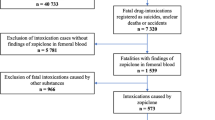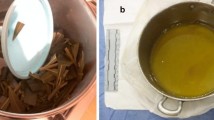Abstract
The histamine content and diamine oxidase activity in the blood and tissues were studied in dogs in the course of evolution of traumatic shock. Phasic changes were found in histaminase activity which led to the development of excessively high histamine levels during the development of traumatic shock. Imbalance between monoamines and histamine is considered to play an important role in the genesis of the hemodynamic and central disorders in shock.
Similar content being viewed by others
Literature Cited
I. L. Vaisfel'd, L. I. Grashchenkov, and G. N. Kassil', Dokl. Akad. Nauk SSSR,164, No. 2, 462 (1965).
I. L. Vaisfel'd, The Histamine—Diamine Oxidase—Histaminopexy System in Some Physiological and Pathological States of the Organism, Author's Abstract of Doctoral Dissertation, Moscow (1969).
I. I. Goncharik, Zdravookhr. Belorussii, No. 8, 23 (1968).
S. A. Eremina, The Mechanisms of Stress, Author's Abstract of Doctoral Dissertation, Rostov-on-Don (1970).
É. Kh. Zakirov, I. V. Smyshlyaev, and F. N. Kazantsev, Vestn. Khir., No. 7, 102 (1972).
Kh. S. Koshtoyants, D. E. Ryvkina, and R. L. Mitropolitanskaya, Dokl. Akad. Nauk SSSR,49, No. 5, 390 (1945).
E. I. Krichevskaya, Dokl. Akad. Nauk SSSR,135, No. 1, 193 (1960).
S. A. Mirzoyan and R. A. Nazaretyan, Dokl. Akad. Nauk Armyansk. SSR, No. 5, 229 (1967).
B. A. Saakov, S. A. Eremina, and B. E. Bagratuni in: Mechanisms of Some Pathological Processes [in Russian], Rostov-on-Don (1970), No. 3, p. 135.
V. I. Uspenskii, Histamine [in Russian], Moscow (1963).
I. M. Khazen and I. L. Vaisfel'd, Vopr. Med. Khimii, No. 5, 493 (1962).
N. Balestrazzi, N. Galante, and P. Pellegrini, Surg. Gynec. Obstet.,93, 518 (1951).
A. M. Dose, J. Physiol. (Paris),62, 368 (1970).
A. Gecse, G. Horpacsy, and S. Karady, Med. Exp. (Basel),19, 277 (1969).
F. McIntire, L. Roth, and J. Shaw, J. Biol. Chem.,170, 537 (1947).
J. Mongar and M. Schild, Physiol. Rev.,42, 226 (1962).
J. Parrot and C. Laborde, Presse Med.,61, 1267 (1953).
S. Rosenthal and H. Tabor, J. Pharmacol. Exp. Ther.,92, 425 (1948).
R. W. Schayer, Science,131, 226 (1961).
K. Wallenfels, L. Kerg, and H. Sund, Klin. Wschr.,36, 772 (1958).
Rights and permissions
About this article
Cite this article
Nesterenko, É.N., Eremina, S.A. & Saakov, B.A. State of the histamine—Histaminase system in the course of traumatic shock. Bull Exp Biol Med 78, 879–881 (1974). https://doi.org/10.1007/BF00803914
Received:
Issue Date:
DOI: https://doi.org/10.1007/BF00803914




